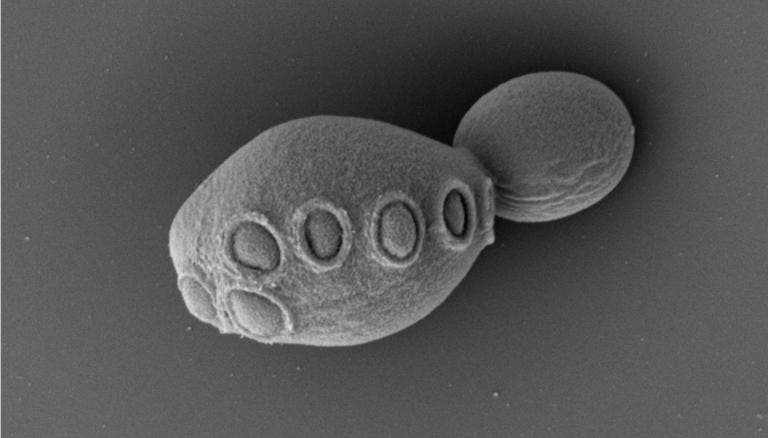Artificial Life: Scientists create first-ever man-made chromosome
Scientists have achieved the unthinkable by creating a synthetic chromosome from scratch for the very first time ever.

[Nov. 9, 2023: Staff Writer, The Brighter Side of News]
In a major breakthrough, scientists have successfully deciphered the intricate and elusive Y chromosome. (CREDIT: Creative Commons)
In a groundbreaking achievement, scientists have achieved the unthinkable by creating a synthetic chromosome from scratch for the very first time. This remarkable feat marks a significant leap forward in the field of synthetic biology and holds tremendous potential for a wide range of applications. Meet the tRNA Neochromosome, a marvel of genetic engineering and the latest triumph of the international Sc2.0 project.
The tRNA Neochromosome, a man-made chromosome belonging to the common baker's yeast Saccharomyces cerevisiae, has the scientific community buzzing with excitement.
The significance of this achievement cannot be overstated, as it opens doors to the creation of synthetic yeast cells that promise to outperform their natural counterparts in numerous ways. Recent studies published in the esteemed scientific journals Cell and Cell Genomics shed light on this extraordinary development.
The Sc2.0 project, an international collaboration of scientists from around the world, has been at the forefront of synthetic biology research. Its ambitious goal is to synthesize all 16 chromosomes of the yeast Saccharomyces cerevisiae and integrate them into a functional cell. The ultimate objective is to engineer yeast cells that are not only faster and more resilient but also significantly more productive.
Related Stories
What makes the tRNA Neochromosome truly special is that it is entirely synthetic, not modeled after one of the yeast's original chromosomes. Patrick Cai, the chair in synthetic genomics at the University of Manchester, international coordinator of the Sc2.0 project, and co-author of the Cell paper, described it as "the world's first de novo synthetic chromosome."
Unlike the other 16 synthetic chromosomes, which were designed based on existing natural chromosomes, the tRNA Neochromosome was meticulously crafted piece by piece using a computer, drawing genetic material from at least nine different species of microorganisms.
Cai explained the novelty of the tRNA Neochromosome by stating, "There is nothing like it in nature. The fact that it can function by producing tRNAs like a natural genome does is pretty amazing. It is also designed to avoid 'head-on collisions' between RNA polymerase and DNA polymerase, which can lead to DNA breaks and other challenges for the cell."
Yeast puzzle. (CREDIT: Creative Commons)
As of now, six and a half of these synthetic chromosomes have been successfully combined within a yeast cell as part of the Sc2.0 project. The potential benefits are vast, with synthetic yeast cells offering the prospect of increased speed, enhanced productivity, and improved tolerance to environmental fluctuations. These applications could revolutionize various industries, including bread production, biofuel manufacturing, pharmaceuticals, and the production of flavors and fragrances.
"These synthetic yeast cells are as normal as the natural cells under normal conditions, but they can transform into 'super-yeast' when the times become tough (e.g., high temperature, high pH)," Cai noted. "Amazingly, these synthetic chromosomes are functional like their natural counterparts in the yeast cells, but they have been endowed with new functions which allow them to on-demand rearrange themselves to adapt to different environments like transformers."
Graphical Abstract. These synthetic yeast cells are as normal as the natural cells under normal conditions, but they can transform into 'super-yeast' when the times become tough (e.g., high temperature, high pH). (CREDIT: Cell Genomics)
One of the most intriguing aspects of this latest synthetic tRNA Neochromosome is its reliance on artificial intelligence (AI) to optimize the genetic qualities of the yeast. Genes from various organisms were incorporated into the design to enhance the yeast's properties, and this synthetic chromosome will eventually be incorporated into the synthetic yeast cells.
Cai elaborated on the design process, stating, "We designed these synthetic chromosomes using computer-assisted designers, which are used to design buildings and cars; then we synthesize these synthetic chromosomes chunk by chunk in the cell by replacing the wild type sequences, similar to you take a book chapter and re-write it paragraph by paragraph until you get a new chapter. Now, all these 16 chromosomes (or chapters if you like) are written, and we are in the final push to bring all of them into a book, the ultimate code of life."
Spot assay of synVII-R intermediate strains. The synVII-R is constructed in orientation from megachunk Y toward megachunk O. (CREDIT: Cell Genomics)
The implications of this groundbreaking research extend far beyond yeast and synthetic biology. The ability to create synthetic chromosomes could have profound implications for human health and genetics. Cai believes that this achievement "will have a huge impact on human health, in ways to direct test driver mutations for diseases and pave the way for better gene therapies." It opens up new avenues for exploring and manipulating genetic mutations, potentially leading to groundbreaking advancements in medical science.
The researchers are now on the brink of completing the final Sc2.0 strain, which will contain all the synthetic yeast chromosomes, including the tRNA Neochromosome. This monumental achievement will mark the birth of the first synthetic eukaryote ever created—a momentous milestone in the history of genetics and synthetic biology.
Construction and physiologic analysis of disomic yeasts. Schematic illustration of the construction of disome yeast strains YSy140 and YSy142. (CREDIT: Cell Genomics)
Cai reflected on the significance of synthetic yeast cells by stating, "These synthetic yeast cells allow us to think about how genome could have been organized. We were given a yeast genome by nature after billions of years of evolution and random selections (which may not be here anymore). Our understanding of genomes is largely based on the observation of these natural genomes. The ability to build synthetic genomes will lead us to a much deeper understanding of the first principles of life."
The creation of the tRNA Neochromosome represents a quantum leap in the field of synthetic biology. This fully synthetic chromosome, designed with the assistance of artificial intelligence, paves the way for the development of synthetic yeast cells with extraordinary capabilities.
As scientists strive to complete the final Sc2.0 strain, the potential applications of this groundbreaking research are boundless. From revolutionizing industrial processes to opening new frontiers in human genetics, the tRNA Neochromosome heralds a new era of scientific discovery and innovation.
Note: Materials provided above by NIH/National Human Genome Research Institute. Content may be edited for style and length.
Like these kind of feel good stories? Get the Brighter Side of News' newsletter.



